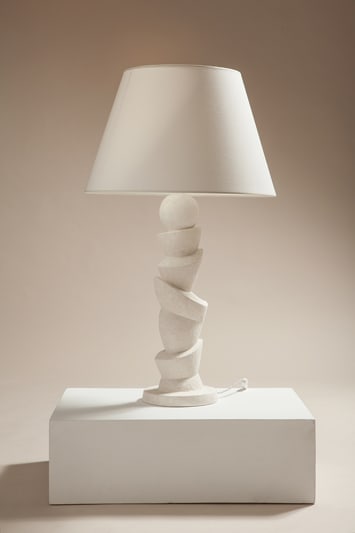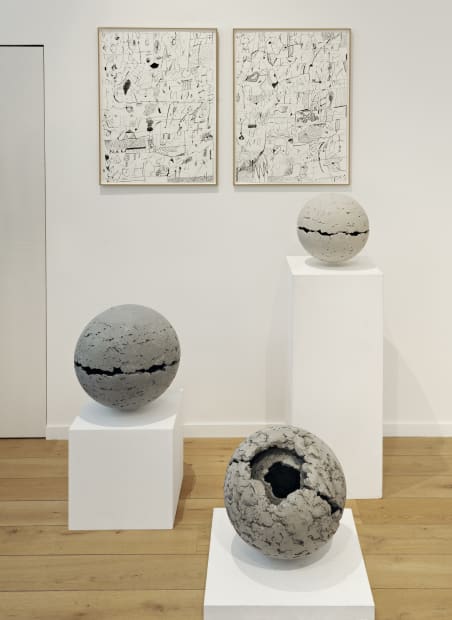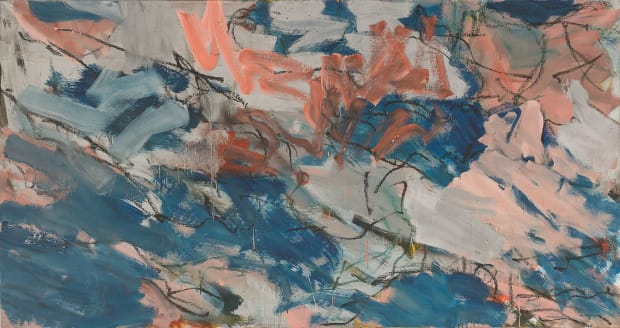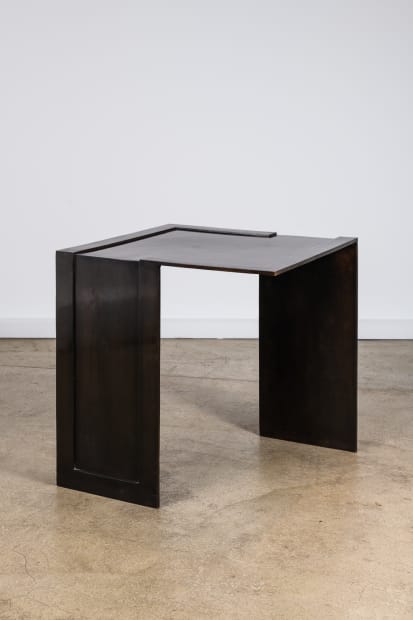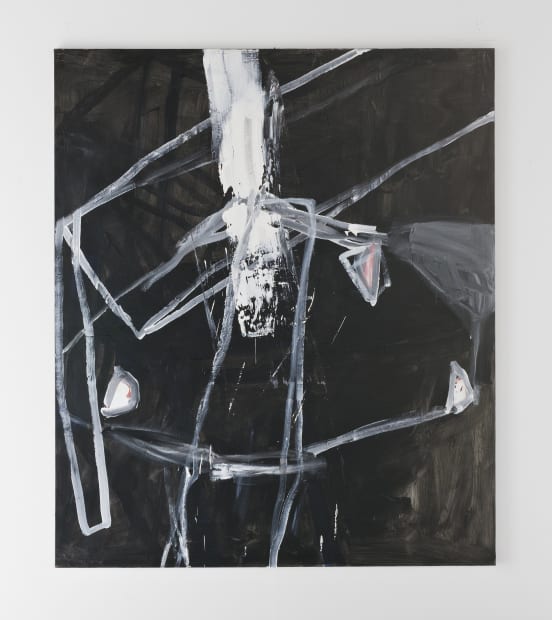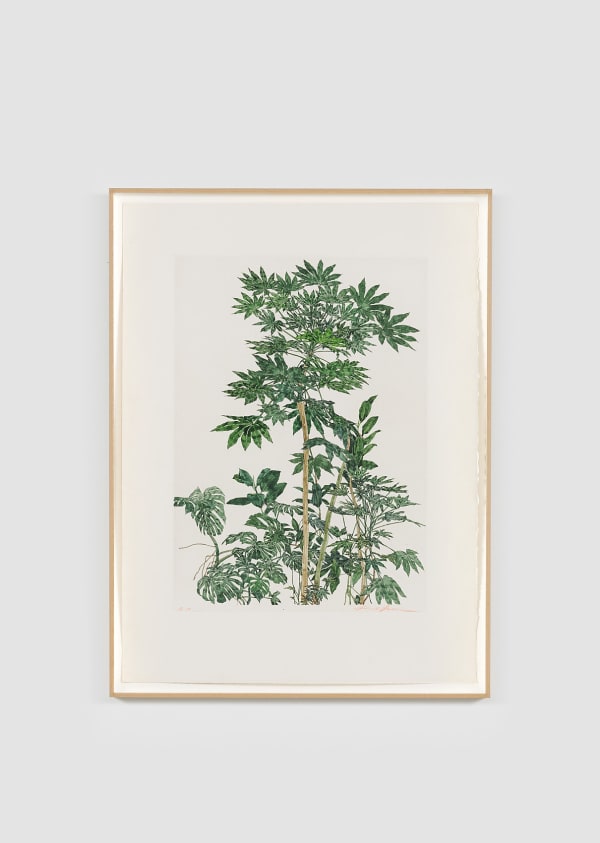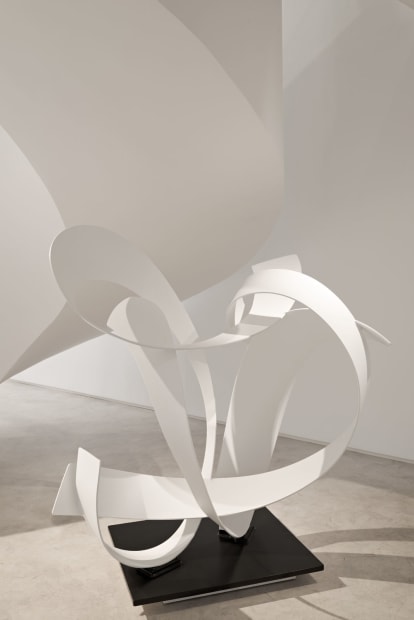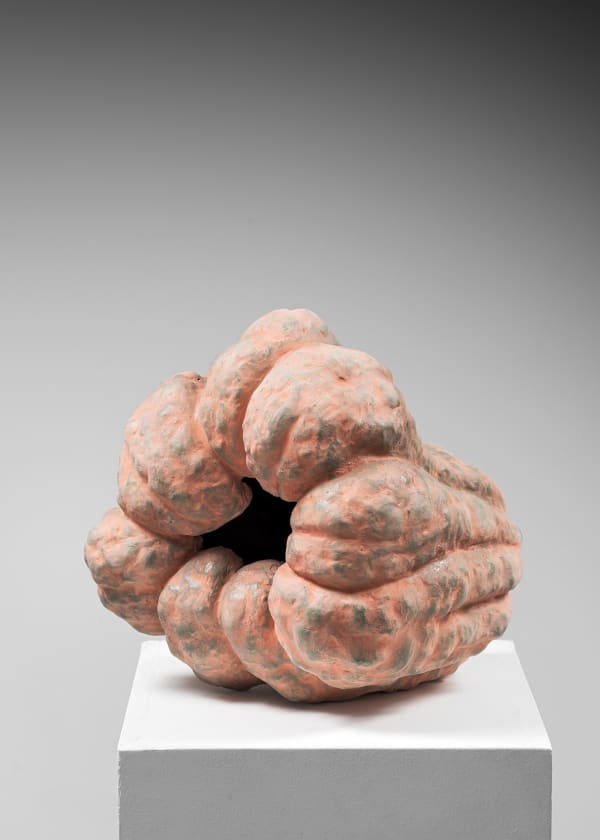-
MONIQUE FRYDMAN
«Je voudrais quelque chose comme l’Orée du monde pour mes tableaux».Artiste majeure de la peinture abstraite, Monique Frydman a souvent évoqué le temps de la peinture et du tableau dans son oeuvre. Quand commence une oeuvre ? A l’Orée, comme quelque chose qui est en train de naitre, de se dilater, à mi chemin entre le désir et la maitrise. Il est toujours question du temps de peindre, et du temps de la peinture dans l’oeuvre de Monique Frydman. Si cette question se posait à l’artiste en 1988, elle est toujours d’actualité dans sa pratique. -

-

-
TED LARSEN
Ted Larsen (né en 1964, États-Unis) est un artiste exposé internationalement, récipiendaire de la Fondation Pollock-Krasner, diplômé de la Northern Arizona University. Le travail qu'il crée fournit des commentaires sur les systèmes de croyances minimalistes et à propos de l'importance ultime de la pratique des Beaux-Arts. Depuis 2001, Larsen utilise des matériaux alternatifs et de récupération dans ses créations.
Le travail de Ted Larsen a été largement exposé dans des fondations privées et des musées aux États-Unis, notamment le New Mexico Museum of Art de Santa Fe, The Albuquerque Museum, The Amarillo Museum of Art, The Spiva Center for the Arts à Joplin, Missouri, et le Philadelphia Museum of Art, ainsi que dans plus de 100 expositions en galerie.
-

-
EUGÈNE PRINTZ
Eugène Printz was born in June 1889 in Paris and passed away in 1948. Son of a cabinetmaker, he did not receive formal academic training but learned in his father's workshop where he copied antique furniture. Starting from 1920, the artist began his research on modern furniture, and in 1925, he exhibited his first personal works. Eugène Printz participated in numerous salons including the Salon des artistes décorateurs, the Salon d'Automne, and the Salon des Tuileries. His success allowed him to have an institutional clientele with the City of Paris as well as a foreign clientele, mainly based in the United Kingdom, North America, and Mexico.
Since always, Eugène Printz cultivated his passion for furniture by visiting museums and immersing himself in the works of his predecessors. Thanks to this exposure to the work of great masters and his years of experience in his father's workshop, he became a perfect technician in cabinetmaking. Printz was able to bring his personal touch to this profession by considering furniture as luxury objects. Therefore, he used noble materials for their manufacture, such as the rarest exotic woods like palm wood or sycamore wood, which he embellished with gilded bronze. The volumes of Eugène Printz are particularly elegant because the artist often enjoyed planning interior arrangements in meticulous detail.
-

-
-

-
BÉATRICE CASADESUS
L’art de Béatrice Casadesus est redevable des oeuvres de la Renaissance Italienne comme de l’art extrême oriental révélé par ses voyages en Asie. La musique imprègne aussi son oeuvre.En quête d’une peinture « qui n’inquiète ni ne trouble » Béatrice Casadesus revendique dès les années 2000 de peindre contre l’horreur du monde. La quiétude et l’épanouissement visuel qui émanent de ces œuvres se retrouvent chez certains grands maîtres de la peinture tels que Turner, Monet, Rothko. Ces peintres, au terme de leur carrière, ne cherchent pas à prouver ou démontrer, mais entrent dans un dialogue exclusif avec la peinture qui ne doit rien au reste du monde. Une peinture profonde et apaisante, née d’une technique particulière de l’empreinte et de la projection de couleurs sur la surface inventée par l’artiste. -

-
VICKY COLOMBET
Vit et travaille entre Paris et New Yorl, Vicky Colombet est une artiste franco-américaine née en 1953.Un étang dans la vallée de l’Hudson, un matinal point du jour, un soleil bleu, un été rougeoyant... Les œuvres de Vicky Colombet s’immiscent dans les chemins que la nature dessine. Invitant la lumière, les matières et l’énergie du paysage à conduire et modeler sa toile, l’artiste y épouse les rythmes du temps, explorant dans l’atelier, les abstractions naturelles du vivant qui écrivent l’instant. Ici, le motif n’est pas ce paysage que les peintres ont longtemps pris pour sujet mais le moyen et l’occasion de s’y plonger, d’en explorer, hors du corps, les sensations qu’il fait naître, les discrètes mais évidentes résonnances qu’il induit. Pas d’horizon, pas de perspective, pas d’échappée. Vicky Colombet ne décrit ni ne dépeint. Sa peinture dissout le motif pour en saisir l’infime essence et la puissante magnitude. La toile devient elle-même nature et paysage, telle une méta-phore de la terre, tellurique, céleste, vivante et fragile.
-

-
PHILIPPE ANTHONIOZ
His sculptures can thus engage in dialogue with interior spaces, whether by transforming a staircase railing or a lighting fixture, or by confronting the space as a domestic object that guides the gaze through the purity of its design: be it a table, bed, or armchair, rendering the unique radiance of the room. Philippe Anthonioz tackles outdoor spaces with the same joy, spaces where nature is preserved, with sculptures that play on the radiance of independent forms, often grouped abstract figures. With him, the obviousness of the artwork is never aggressive and first and foremost becomes a visual conquest.
Respect for the heavy material history of woods as well as the richness of bronze, the confrontation between creations and usage thus form shapes capable of simultaneously captivating the eye and fostering intimacy, a contemplative state against all kinds of formattings that assault us. Thanks to Philippe Anthonioz, the functional is poeticized, and the purpose of sculpture fully enters into the art of living. It is with 21st-century means, a return to origins, and a reconquest that he deserves acknowledgment.
-

-

-
JEAN-FRANÇOIS LACALMONTIE
Depuis la fin des années 70, Jean-François Lacalmontie poursuit une oeuvre échappant à la plupart des classifications traditionnelles.Dans un premier temps son travail consiste, d’une façon compulsive, à remplir quotidiennement de milliers de signes des pages d’innombrables carnets . Evoquant parfois des sortes d’idéogrammes, ni tout à fait abstraits, mais jamais totalement figuratifs, ces formes, ces « choses », ces « objets » comme il les nomme, nourrissent un répertoire de formes constituant son alphabet formel fondamental. S’apparentant à une sorte d’écriture sans contrôle rationnel, ce processus de distanciation permet une essentialisation du geste graphique, dont les émergences obsédantes questionnent les conditions d’apparition de la forme. -
CLAUDE DE SORIA
Claude de Soria was born in 1926 in Paris and died there in 2015. Passionate about art from a young age, she took drawing lessons first with André Lhote at the Académie de la Grande Chaumière, then with Fernand Léger (1950) before discovering sculpture with Ossip Zadkine (1952). In 1953 she married and moved to the countryside for the next 10 years. It was during this period that Claude de Soria worked primarily with clay.
After returning to Paris, the artist was inspired by models that became more and more abstract: fruit, flowers…and the artists whose works she admired through their exhibitions: Picasso at the Grand and Petit Palais (1966), Degottex (1967) then Hantaï (1968) at the Galerie Fournier, Giacometti (1969) at the Orangerie in the Tuileries, Matisse (1970) at the Grand Palais and the Bourgeois of Calais de Rodin. In 1972 the natural landscapes that she discovered during a trip to the Sahara elicited what amounted to an internal revolution, which was followed by a period of uncertainty.
It is in part thanks to a sac of concrete left behind by one of the construction workers in the backyard of her studio that in 1973, she found her path. From that instant she understood all the possibilities she could explore with this volatile, malleable, buildable material. Over time she built upon multiple experiments: different quantities and different qualities of concrete powder, sand, fiber, water, interior structures that she tested as well as all sorts of containers and supports: glass, rhodoïd, tissue, paper…leading to a genesis of shapes: circles, squares, rectangles, spheres, cylinders…making sure to leave open the possibilities of chance: « I try, with my attitudes of vigilant listening, of availability, floating attention, to not miss any innovation that comes by chance… ». As explained by the artist, this was more of a constant awareness of the material within the frame of a body of work that is always evolving and ready at all times to be questioned and reworked. The process consists of an itinerary between both the artist and her material, but without a long term goal. The exploration of multiple pathways is done with the intention to walk and to explore, to enjoy the landscape that is present and to wait with enthusiasm the apparition around the corner, of a new panorama to admire.
De Soria’s works can be found today in different private and public collections and have been exhibited in numerous institutions: Musée d’Art Moderne (Paris), Centre Pompidou (Paris), Musée Picasso (Antibes), Bibliothèque Nationale (Paris), Musée National des Arts Décoratifs (Paris), Fondation Cartier (Paris), … -

-
CHRISTIAN SORG
Christian Sorg, né à Paris en 1941, est un peintre français qui vit et travaille en France. Sa formation débute aux Arts Appliqués, par le choix de l’atelier de sculpture. Son parcours se poursuit à l’École Nationale des Beaux-Arts de Paris, où il développe son rapport à la peinture. Au fil des années, Christian Sorg crée un véritable langage pictural qui lui est propre, dans lequel il invente sa méthode d’appropriation du réel.
A partir de l’expérience vécue, physiquement éprouvée, Christian Sorg dessine, peint, trace et transpose sur la toile la forte présence des oeuvres de l’humanité des premiers jours, la fragilité du monde et de l’environnement, l’éphémère éclat de la vie. Christian Sorg est une voix d’aujourd’hui qui renoue avec les échos les plus lointains.
-

-
ERIC SCHMITT
Eric Schmitt is one of the most creative artists continuing the Art Deco tradition. He is at the cutting edge of sculpture, architecture and design. His work features contemporary, fluid forms that have been melted, carved or blown using solid materials such as bronze, alabaster, marble and Bohemian glass.
After focusing on lines and right angles, Schmitt has turned his attention to curves. His pieces respect geometrical rules while symbolically evoking natural forms. He creates, designs and shapes pieces in his workshop before entrusting them to the best craftsmen in France.
-
-

-
MAX WECHSLER
Les « Papiers Marouflés »; des fragments d’écritures diverses de toutes origines transformées par la copie couvrent des surfaces qui n’ont ni bord ni centre . Max Wechsler libère la lettre de l’enchaînement sémantique. Devenues illisibles par le processus de la réduction ou de l’agrandissement, la distorsion à l’extrême les lettres deviennent signe, énigme. « L’illisibilité s’empare de l’espace où ça et là subsiste des fragments de son origine écrite » (M.W.)Cette illisibilité, du noir profond au blanc qui interroge, témoigne du désir de Max Wechsler de « reconquérir cet autrefois… de la langue, du mot, de la lettre… » (M. W., 2007). -

-
MAREK SZCZESNY
La peinture de Szczesny ne doit pas s’appréhender sous un angle purement formel. Elle traduit avant tout une force morale et éthique, ainsi qu’une grandeur tragique, même dans les pièces les moins figuratives. La formule d’Henri Focillon « la main fait l’esprit, l’esprit fait la main » pourrait avoir été inventée pour lui. Il y a en effet chez Szczesny un arrière monde, qui n’affleure pas nécessairement à sa conscience, mais qui s’exprime à chaque coup de pinceau. Ses lignes impérieusement tracées qui se chevauchent, suffisent à produire chez le regardeur un choc émotionnel proche de la sidération. Les grands formats qu’il affectionne ajoutent certainement à cette solennité tragique, ainsi que, depuis quelques années, la réapparition de la figure humaine. Celle-ci se manifeste sous forme d’une simple silhouette dont seul le contour est tracé. Ce corps, naïvement et pauvrement dessiné, par son vide même, devient le réceptacle et la projection de notre angoisse existentielle. L’Homme de Szczesny c’est la victime innocente de toutes les tragédies qui nous adresse son cri muet. « Ce qui nous intéresse, confirmait Picasso, c’est le drame de l’homme. Le reste est faux ». -

-
BRUNO ROMEDA
Fascinated by ancient Italian architecture, Bruno Romeda focuses on elemental shapes—circle, square, triangle. He doesn’t invent new forms but rather explores the infinite variations offered by the basic vocabulary of geometry, opening the door to mental constructions, and even architectures. In fact, a sculpture by Bruno Romeda is awarded to the winners of the Équerre d’Argent prize.
Typically seen as a solid volume to be navigated around, a Romeda sculpture offers a threshold, a mirror absent from the world, "or rather, the presence of its absence" (Pierre Restany), and creates a conceptual framework for our vision. By choosing the three basic shapes, he opts for repetition and infinite variation—almost meditative variations. His restraint and economy invite calm and reflection. Yet, this calm is subtly disturbed by the tension brought about by the roughness of the bronze. Thus, we can ask ourselves, as Pascal Bonafoux does: "And if absence, the kind of absence that is a Romeda sculpture, pointed to the very anxiety of the century regarding what it has accepted as art?"
-

-
JEAN-PIERRE PINCEMIN
Pour Pincemin, la gravure– comme la peinture et la sculpture – relève de l’expérimentation et ne se laisse pas enfermer dans la technique. Ainsi c’est une multitude de procédés qui seront utilisés, inventés et développés par l’artiste, dans diffèrents ateliers, en collaboration avec des imprimeurs comme Pasnic ou Piero Crommelynck.
Pincemin pratique régulièrement la gravure depuis 1985, ses premières estampes datent de la toute fin des années 70. « C’est en 1979, gràce à la bonne rencontre de Jacques Putman, et à son inten- tion d’éditer ce qui sera un jour mes gravures, que la chose entra dans ma vie. ». Les Putman éditent des gravures, parfois en collaboration avec Marie-Hélène Montenay. Dans les années 80, l’artiste travaille à l’atelier Pasnic, la pointe-sèche sur plexiglass et de grands bois gravés au marteau-piqueur et réhaussés. À cette période, sa femme Françoise Pincemin imprime aussi nombre de gravures dans son atelier à Authon-la-Plaine. Une importante collaboration s’établit ensuite avec l’atelier Piero Crommelynck qui tire de belles aquatintes au sucre, en noir et blanc, parfois en couleur, notamment gràce à l’introduction des papiers collés.
-

-
ROBERT COURTRIGHT
The apparent simplicity of Courtright's works actually reveals an incomparable world, both sophisticated and clever, yet reduced to the essential: grids composed of neatly arranged rectangles of glued paper. These frameworks, these constructions, serve as the expressive stage for a palette of colors ranging from blood red to sunshine yellow. Vibrant and saturated or pale, the colors play on the irregular surfaces of the glued papers, which are meticulously cut and rearranged.
Courtright's attachment to geometry is nourished by a particular attention to architecture. Since a foundational trip to Rome in 1952, surfaces and façades—flat but with infinite variations and roughnesses gleaned from Italian buildings and those of southern France—have occupied his mind. His early collages, depicting structured architectures, testify to this fundamental attraction.
-

-
SAM SZAFRAN
La trajectoire de Sam Szafran n’est comparable à aucune autre. Enfant d’une famille juive polonaise, il a connu pendant la guerre l’ébranlement d’un monde et l’écroulement de l’enfance. La pratique du dessin et de la peinture lui ont offert cet ancrage dans le réel qu’une vie menacée par les dangers de l’Histoire lui avait refusé. En autodidacte, avide de savoir, il a tenu le cap de sa création, retiré dans son propre univers. Dans le secret de l’atelier, Sam Szafran a poursuivi les obsessions dont son œuvre est empli sans détourner le regard. Laissant de côté les débats de son temps, il a choisi la figuration dans une période qui y avait renoncé ou qui l’entraînait dans de tout autres directions. Contemporain des dernières avant-gardes, le peintre s’en est tenu à l’écart tout en les observant avec attention, cultivant un goût pour les techniques passées de mode comme le pastel et l’aquarelle.
À la fin des années 1970, Szafran commence à travailler à l'aquarelle, une technique dont il se sert à l'origine pour rehausser les gravures réalisées à l'atelier de son ami Piero Crommelynck. Combiner le pastel et l'aquarelle, réaliser une synthèse entre « le sec et le mouillé » comme avant lui Degas, devient un nouveau défi, auquel il se consacre particulièrement dans ses séries de plantes.
-
-
Patrick E. Naggar
At the heart of Naggar's approach is a fascination with the history of forms, from Antiquity to the present day, combined with a quest for modernity. He stands out for his ambition to renew forms, to sublimate industrial materials, and to bring art and science into dialogue in his creations. He devotes himself to the creation of furniture, objects and spaces, combining different cultures and integrating contemporary research. This resolutely modern and elegant work is expressed in a visual language rich in symbols and imbued with poetry.
At the heart of Naggar's approach is a fascination with the history of forms, from Antiquity to the present day, combined with a quest for modernity. He stands out for his ambition to renew forms, to sublimate industrial materials, and to bring art and science into dialogue in his creations. He devotes himself to the creation of furniture, objects and spaces, combining different cultures and integrating contemporary research. This resolutely modern and elegant work is expressed in a visual language rich in symbols and imbued with poetry.
-

-

-
VLADIMIR ZBYNOVSKY
La lumière et le temps sont les notions majeures de la recherche artistique de Vladimir Zbynovsky. Par ses principes physiques, la lumière l’incite à une méditation existentielle, génératrice d’œuvres témoignant à la fois de la transformation de la matière et de la conscience de la fugacité humaine. Dès l’origine, son œuvre s’interroge : qu’est-ce que le temps ? quel est son moteur ? Questions qui naturellement engendrent une réflexion sur la naissance de la matière. D’où la volonté de réunir deux matériaux différents mais qui tous deux évoquent la naissance de l’univers : la pierre et le verre, médium de lumière.
Ses œuvres aux titres évocateurs révèlent une quête de la matière aux confins du spirituel. Elles rappellent que l’univers dispose d’une vie propre, non conditionnée à l’apparition ou à la disparition des hommes, que la vie est un principe plus vaste que ce à quoi nous le réduisons, que la lumière est une énergie vitale sans commune mesure. Alors l’artiste use de tous les subterfuges de son art pour transformer ses sculptures en points de passage d’une dimension à une autre, tel des autels reliant le monde terrestre à un au-delà. Ainsi, personne de s’étonna de voir la réalisation d’un nouvel autel pour la basilique Saint-Denis lui être confié. La lumière appelle la lumière.
-

-
BENOIT LEMERCIER
Benoit Lemercier is a French sculptor born in 1965.
He works in Paris and in his studio in Loiret.In 2000, Benoit Lemercier created an artistic movement that he named "Mathematism" (registered trademark). Through this, he aims to demonstrate the predominance of mathematics in the functioning of the universe. For him, the notions of time and space are concepts elaborated by the human brain, which do not correspond to objective reality. The matter surrounding us is an illusion that only appears solid. It is the materialization of the form taken by energy at a given moment when encountering undulations in the quantum field. This energy is a vehicle that carries a constant flow of perpetually moving information, guided by a source of information: consciousness. Through his work, the artist aims to question us about the nature of this consciousness.
Benoit Lemercier's sculptures are present in the collections of the National Fund for Contemporary Art (FNAC) and in significant institutional and private collections in France (Espace de l'art Concret, Société Générale Collection, Ar'Milin Collection, Bouvet-Ladubay Collection...), as well as in Switzerland, Luxembourg, Belgium, Germany, Greece, Great Britain, Russia, and the United States.
-

-
CHIEKO KATSUMATA
Chieko Katsumata, an architecture graduate with a special interest in industrial design, was introduced to ceramics in France in 1973 by the artist Fance Franck, a specialist in Chinese “sang de bœuf” (oxblood) glazes. She studied at the École Nationale Supérieure des Arts Appliqués, then returned Kyōto where she completed her training at the University of Arts in Ōsaka under the avant-garde ceramicist Mutsuo Yanagihara. She developed a technique of layered coloured slips to produce a particular texture. Her works are deeply inspired by the natural world, such as this “French Pumpkin” in the Cernuschi Museum, expressed in imposing, open forms. Her works are exhibited in numerous national and international museums, including the National Museum of Modern Art in Tokyo and the Museum of Modern Ceramic Art in Gifu.
-
-
VLADIMIR SKODA
After studying metalworking at the Technical School of Slaný and later in Prague, Vladimir Skoda moved to France in 1968, where he trained at the School of Fine Arts in Grenoble and Paris. Throughout this period of education, he was as interested in theory as in practice, as well as in science and technology. From 1973 to 1975, he was a resident at the Villa Medici in Rome, where he sculpted geometric forms inspired by mathematics. Starting in 1979, Vladimir Skoda focused particularly on the sphere—its perfect or disrupted geometry, its polishing or roughness, its reflective or matte appearance. The spheres are often arranged in space like constellations, reflecting his passion for astronomy.
In 1995, he introduced movement into his work by creating pendulums that reveal a distortion of space, such as *Kora* (1996, MAC/VAL). Alongside this sculptural work, his activities as a draftsman and engraver also illustrate his fascination with space, optical phenomena, and astronomy.
-

Winter Group Show: DUTKO / Quai Voltaire
Current viewing_room











